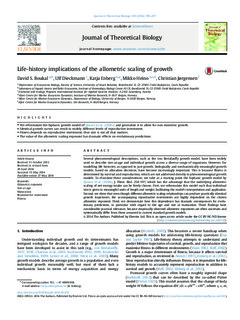| dc.contributor.author | Boukal, David S. | |
| dc.contributor.author | Dieckmann, Ulf | |
| dc.contributor.author | Enberg, Katja | |
| dc.contributor.author | Heino, Mikko | |
| dc.contributor.author | Jørgensen, Christian | |
| dc.date.accessioned | 2014-10-01T14:43:31Z | |
| dc.date.available | 2014-10-01T14:43:31Z | |
| dc.date.issued | 2014-05-27 | |
| dc.identifier.citation | David S. Boukal, Ulf Dieckmann, Katja Enberg, Mikko Heino, Christian Jørgensen, Life-history implications of the allometric scaling of growth, Journal of Theoretical Biology, Volume 359, 21 October 2014, Pages 199-207, ISSN 0022-5193, http://dx.doi.org/10.1016/j.jtbi.2014.05.022. | nb_NO |
| dc.identifier.issn | 0022-5193 | |
| dc.identifier.issn | 1095-8541 | |
| dc.identifier.uri | http://hdl.handle.net/11250/222703 | |
| dc.description.abstract | Several phenomenological descriptions, such as the von Bertalanffy growth model, have been widely used to describe size-at-age and individual growth across a diverse range of organisms. However, for modelling life histories, as opposed to just growth, biologically and mechanistically meaningful growth models, based on allocation decisions, have become increasingly important. This is because fitness is determined by survival and reproduction, which are not addressed directly in phenomenological growth models. To elucidate these considerations, we take as a starting point the biphasic growth model by Quince et al. (2008a, J. Theor. Biol. 254:197) which has the advantage that the underlying allometric scaling of net energy intake can be freely chosen. First, we reformulate this model such that individual size is given in meaningful units of length and weight, facilitating the model׳s interpretation and application. Second, we show that even though different allometric scaling relationships can produce practically identical growth trajectories, the accompanying reproductive investments are highly dependent on the chosen allometric exponent. Third, we demonstrate how this dependence has dramatic consequences for evolutionary predictions, in particular with regard to the age and size at maturation. These findings have considerable practical relevance, because empirically observed allometric exponents are often uncertain and systematically differ from those assumed in current standard growth models. | nb_NO |
| dc.language.iso | eng | nb_NO |
| dc.publisher | Elsevier | nb_NO |
| dc.title | Life-history implications of the allometric scaling of growth | nb_NO |
| dc.type | Journal article | nb_NO |
| dc.type | Peer reviewed | nb_NO |
| dc.subject.nsi | VDP::Agriculture and fishery disciplines: 900::Fisheries science: 920 | nb_NO |
| dc.source.pagenumber | 199-207 | nb_NO |
| dc.source.volume | 359 | nb_NO |
| dc.source.journal | Journal of Theoretical Biology | nb_NO |
| dc.identifier.doi | 10.1016/j.jtbi.2014.05.022 | |
